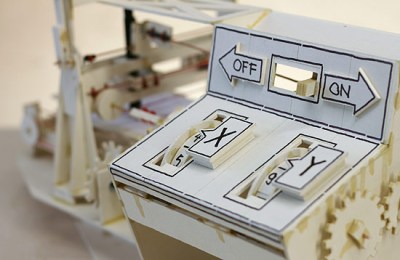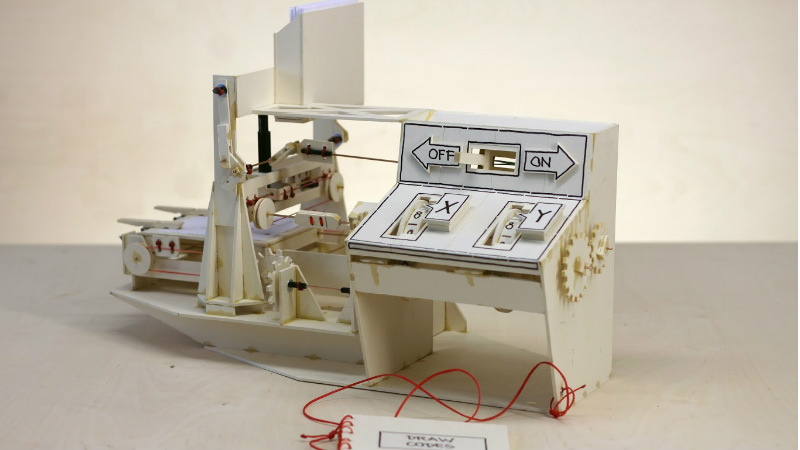If you’ve been hanging around Hackaday for any length of time, you’ve undoubtedly seen the work of [Niklas Roy]. A prolific maker of…everything, we’ve covered his projects for over a decade now. He’s one of an elite group of hackers who can say they’ve been around since Hackaday was still using black & white pictures. Yet sometimes projects fall through the cracks.
 Thanks to a tip sent in from one of our beloved readers, we’re just now seeing this incredible cardboard plotter [Niklas] made for a workshop he ran at the University of Art and Design Offenbach several years ago. The fully manual machine is controlled with two rotary dials and a switch, and it even comes with a book that allows you to “program” it by dialing in specific sequences of numbers.
Thanks to a tip sent in from one of our beloved readers, we’re just now seeing this incredible cardboard plotter [Niklas] made for a workshop he ran at the University of Art and Design Offenbach several years ago. The fully manual machine is controlled with two rotary dials and a switch, and it even comes with a book that allows you to “program” it by dialing in specific sequences of numbers.
Not that it detracts from the project, but its worth mentioning that the “cardboard” [Niklas] used is what is known as Finnboard, a thin construction material made of wood pulp that looks similar to balsa sheets. The material is easy to work with and much stronger than what we’d traditionally think of as cardboard. Beyond the Finnboard, the plotter uses welding rods as axles and slide rails, with glue, tape, and string holding it all together.
The dials on the control panel correspond to the X and Y axes: turning the X axis dial moves the bed forward and backward, and the Y dial moves the pen left and right. The switch above the dial lowers and raises the pen so it comes into contact with the paper below. With coordination between these three inputs, the operator can either draw “freehand” or follow the sequences listed in the “Code Book” to recreate stored drawings and messages.
Believe it or not, this isn’t the first time we’ve seen somebody made a plotter out of cardboard. Though previous entries into this specific niche did use servos to move around.
[Thanks to Setvir for the tip.]
















It’s…interesting. I won’t be trying this. Sorry.
Why are you sorry? If it’s too much of a pain in the ass … then that’s it. But yes – it IS interesting. And could be automated.
But why would you want to automate it? I don’t think that was the point of the project. I wouldn’t build something like this because it’s cardboard. Could have been made out of butter, or bread, or anything else weird.
Is there an equivalent of finnboard sold in USA? I guess a lot of us use foamcore or matte board.
That’s an excellent question. If there is, I haven’t had any luck finding it online. Would be very interested to hear from one of the readers if there’s a viable alternative.
This guy just started the industrial revoloution!
The drawing he shows at the end of the video is not the one he made in the video. The middle vertical stroke of the W is different and the polygon for the o does not end where it starts.
5 years old…
So what?
If you’re one of those 3D printer folks who has never looked at GCode — it’s this. A string of notes telling you to move here, this fast, and drop the pen. Actually doing it by hand is kinda instructional. Also kinda mental. :)
https://diyodemag.com/education/kids_coding_think_like_a_computer There is an article in DIYODE magazine this month for teaching kids about coding which performs algorithms with pictures and cards. Again an very physical representation of coding like this is to G -Code
Very much lik would have been found in an Usborn computer book in the 80’s
bought a vinyl cutter and 3d printed a pen holder for 28 bucks shipped
Could you please point to where you bought a vinyl cutter for such a tantalizingly low price?
add card code
simple card with holes to creating program.